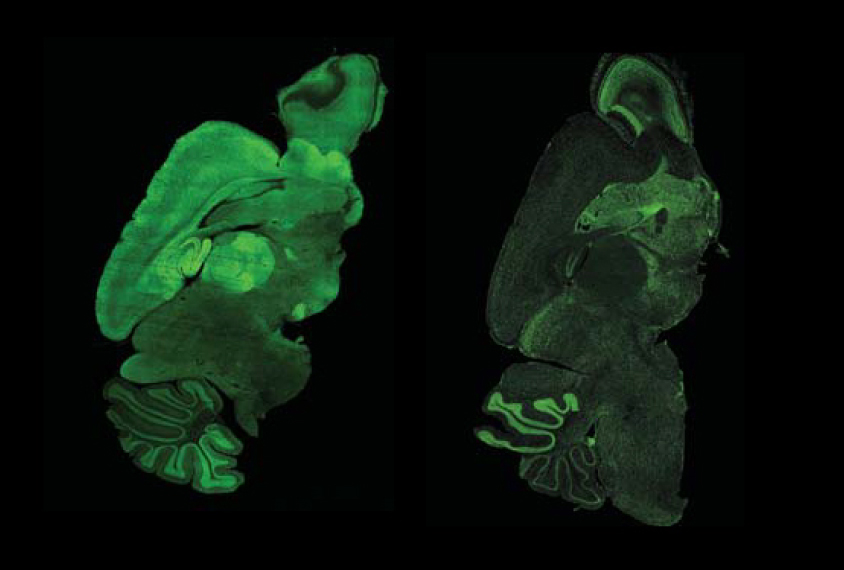
Two types of neurons play key roles in Rett syndrome
Manipulating MeCP2, the gene mutated in Rett syndrome, has revealed two neuron types as crucial contributors to the condition.
Removing or restoring the Rett syndrome gene, MeCP2, in two mouse neuron types reveals that each type underlies distinct features of the condition1,2. The findings suggest that therapies designed to treat Rett syndrome should target neurons that boost brain activity as well as those that inhibit it.
“You can’t just tweak one side of the coin,” says lead investigator Huda Zoghbi, professor of molecular and human genetics at Baylor College of Medicine in Houston, Texas. “You have to tweak both sides of the coin to keep a balance.”
Most cases of Rett syndrome stem from mutations that disable a copy of MeCP2, a gene located on the X chromosome. This leads to social and motor problems, seizures, a shortened lifespan and, in about 60 percent of cases, autism3.
Zoghbi and her colleagues refined the role of MeCP2 in neurons that suppress brain activity via the chemical messenger GABA, as well as those that excite cells via the chemical messenger glutamate. The researchers presented preliminary results at the 2013 and 2015 meetings of the Society for Neuroscience. They published the results in two new papers in June in eLife.
Their work suggests that social problems and repetitive behaviors stem from MeCP2 loss in inhibitory neurons, whereas anxiety and tremor result from MeCP2 loss in excitatory ones.
“These two papers combined are a landmark contribution,” says Lucas Pozzo-Miller, professor of neurobiology at the University of Alabama at Birmingham, who was not involved in either study. “They have provided a picture of the behavioral symptoms driven by each neuronal population.”
Two targets:
Mice that lack MeCP2 throughout the brain have several Rett-like symptoms. In 2010, Zoghbi’s team reported that they had created male mice that lack MeCP2 only in inhibitory neurons. The mice show many of the problems seen in Rett, including premature death, repetitive behaviors and social problems. But they do not have anxiety or tremors.
In the new work, Zoghbi’s team confirmed inhibitory neurons’ importance in Rett by expressing MeCP2 in only those neurons in mice that lack the gene throughout the brain. They found that these animals show few of the features of mice missing the gene in inhibitory cells, and live to nearly 2 years of age. But these mice still show some anxiety and have tremors.
To find the source of the anxiety and tremors, Zoghbi’s team eliminated MeCP2 in only the excitatory neurons of male mice. These mice have anxiety and tremors, die young, and have several other Rett-like features. But they do not have social problems or repetitive behaviors.
The researchers then expressed MeCP2 in only these excitatory cells in mice that lack the gene throughout the brain. They found that this reverses all of the mice’s problems, except for motor issues and seizures.
Taken together, the results indicate that social problems and repetitive behaviors stem largely from a malfunction of inhibitory neurons, and anxiety and tremors from excitatory neurons. Anomalies in either type of cell result in premature death, obesity and motor problems.
Treatments for Rett syndrome must account for this patchwork origin of its features, Zoghbi says. “I think this tells us we really need to target both systems in parallel,” she says.
Female findings:
Zoghbi’s team also explored the role of MeCP2 in female mice, because Rett is much more severe in boys than in girls. They looked at female mice that lack MeCP2 in roughly half of their brain cells, similar to the situation in girls with Rett syndrome. These mice have a normal lifespan, but they are overweight and have tremors, breathing and motor difficulties, anxiety and social problems.
Restoring MeCP2 levels to normal in the inhibitory neurons of these mice is less effective than in males: It only partially prevents obesity, motor problems, social difficulties and anxiety. By contrast, adding the gene back to excitatory neurons works better in female mice than in the males: It almost completely prevents obesity and alleviates tremor, anxiety and motor problems.
“We saw different degrees of rescue in both types of neuronal rescues in the male versus female mice,” Zoghbi says. “This was really a surprise.”
It’s unclear why the effects differ with sex, but Zoghbi says it may be because half of the brain cells in the females have normal levels of MeCP2.
References:
Recommended reading

New organoid atlas unveils four neurodevelopmental signatures

Glutamate receptors, mRNA transcripts and SYNGAP1; and more

Among brain changes studied in autism, spotlight shifts to subcortex
Explore more from The Transmitter
Can neuroscientists decode memories solely from a map of synaptic connections?

AI-assisted coding: 10 simple rules to maintain scientific rigor
